Contents
HELLO DEAR , IF YOU NEED TO DOWNLOAD THE MANUALS AND FORMULAS AND EBOOKS FOR 27 EXPERIENCED EX-HOLCIM ENGINEER PLEASE CLICK HERE NOW, THIS IS THE ULTIMATE ESSENTIAL PACKAGE CONTAIN BOOKS , PROCESS MANUALS AND EXCEL SHEETS FOR CALCULATIONS.
selection and purchasing guide of hammer crusher
Hammer crushers are widely used in the cement industry. They are used for size reduction of hard to medium hard limestone, and sometimes for marl crushing. Hammer mills work with reduction ratios as high as 1 : 60; depending on the crusher feed, this ratio can increase to 1 : 80. Sometimes the high reduction ratio of hammer crushers does away with the need for the installation of multi-stage crushing plants.
. These crushers work with the impact effect of the hammers according to the formula for the kinetic energy or impact (P):
P= (m. V2)/ 2
Starting from this point the mass of the hammers in hammer mills was reduced to a minimum while at the same time increasing the velocity v as far as possible. The result was greater impact force combined with reduced wear.
In both types of crushers the crusher feed first passes through to upper or primary grid; this follows preli minary size reduction of the material by the impact hammers. The final crushing then occurs on the bars of the lower grid. Because of the two grids with different spacings, the hammer mills can be considered two-stage crushers. An adjustment of the grid spacing controls the final particle size; the final particle size is approximately equal to one half of the grid spacing. The grid spacing of the lower grid is generally 25- 30 mm. Higher moisture content of the crusher feed requires larger spacings up to 60 mm. Depending on the requirements, a spacing of 200 mm can also be applied. Moist and sticky crusher feed requires triangular grate bars; otherwise trapezoidal bars are in use.Since the primary grid sometimes caused operational disturbances, new models of hammer crushers are build without this grid.
The impact of the hammers upon the crusher feed is not even; this means the load upon the crusher and the drive motor is not continuous. Massive flywheels are used to stabilize the operation. The double rotor crusher has separate drive motors for each shaft.
The weight of the replacable impact hammers is in the range of 20 to 200 kg each, depending upon the crusher size. The chemical composition of the hammer steel is:
c = 1.0- 1.4 %
Si = 0.4- 1.0 %
Mn = 12.0-14.0 %
p = 0.06%
Depending upon the hardness of the crusher feed, the specific wear of the impact hammers is 1.5 to 3.0 grams per ton of crushed material. The wear rate of Cr-Va-steel is 3 grams and that of Cr-Si-Va-steel was estimated to 2 grams per ton of crushed material [47].
The rim speed of the hammers is in the range of 25 to 50 m/s.
The number of revolutions of both the single and double rotor crushers is in the range of 250- 400 rpm, depending upon the crusher size.
The power demand of single rotor crushers is between 1.3-2.8 HPh/t; double rotor crushers have an energy demand of 1.8-2.5 HPh/t of crushed material.

.
.
the figure shows six different design modifications of impact hammers for hammer mills [47a].
To estimate the throughput capacity of a hammer breaker for limestone, the following empirical formula was developed:
Q = (40) · D · L
Q Throughput of hammer breaker, m3/h
D Rotor diameter of rotating hammers, meter
L Useful length of rotor, meter
Example
Estimate the capacity of a hammer breaker; D = 1.7 meter, L = 1.3 meter.
Q = 40 · 1.7 · 1.3 = 88 m3/h
Assuming a bulk density of the crushed limestone of 1.6 t/m3, the capacity expressed in tons is
88 . 1.6 = 140 t/h
The required power input can be calculated using the following formula:
N = (0.1 – 0.15) x i x Q
N Motor size, kW
i Ratio of reduction
Q Hammer mill capacity, tph
Another, more precise formula for the derivation of the required power input reads:
.

.
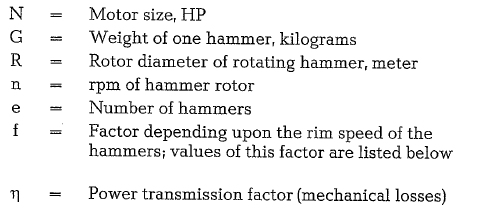
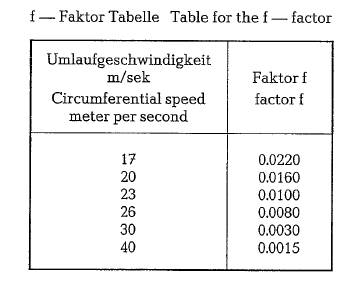
.
.
.
Example :
Estimate the required power input for a double rotor hammer crusher with 2 x 16 hammers; weight of one hammer is 30 kg; speed of rotors is 250 rpm, rotor diameter is 1.0 meter, and power transmission factor is 0.85
Solution:
The rim speed for determining the £-factor is

.
From the preceding table the £-factor for 26 m/s is
0.008. Thus the required drive energy for both motors
is

Hence, two motors with 88 HP or 65 kW each should be provided; the next higher available motor size should be selected.

.
.

.
.
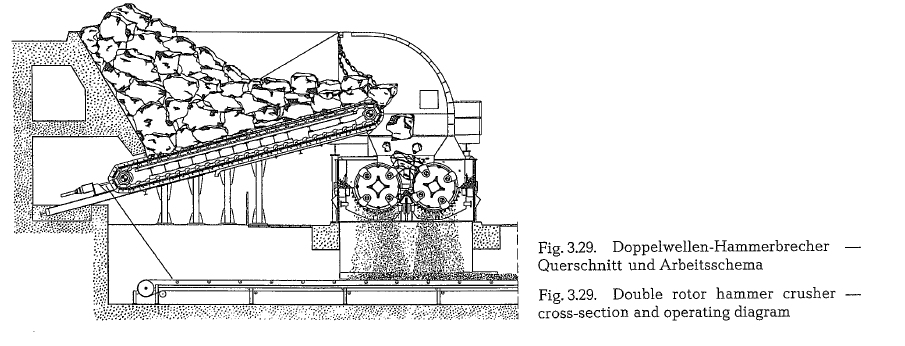
.
.
Fig. 3.29. shows the cross-section and the operating diagram of a double rotor hammer crusher in standard design
The following table contains technical data for the 0 + K double rotor hammer crusher “Titan” for crush

.
.
.
.
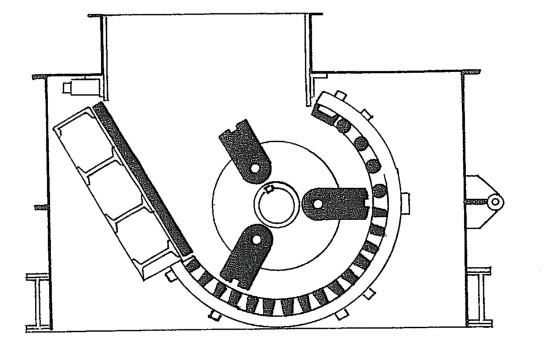
.
.
.
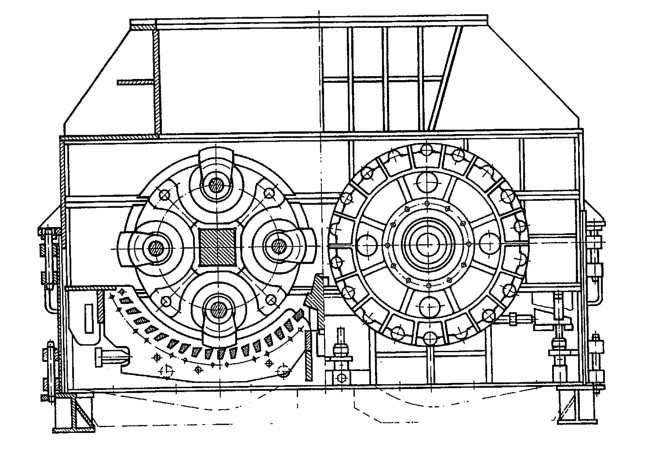
when to use Hammer Crusher ?
Hammer crusher used with material that have moisture content less than 12% , with compressive strength less than 120MPA , such as limestone, oil shale, slag, coal and so on.
Hammer crusher crushing concept
is very simple : the ore is crushed by the impact force of the hammer plus the impact force of the ore and the lining of grates and the impact force of the ore itself , the ore crush each others.
Hammer Crusher classifications :
hammer crusher can be classified into four types:
first classification: according to the number of rotors ( single rotor and double rotor )
second classification : according to the rotation direction ( reversible and nonreversible types )
third classification : according to the arrangement of hammers ( into single row and multi-row types )
fourth classification : according to the different uses ( divided into two types of general purpose and special purpose)
1.1 Advantages and disadvantages of hammer crusher
Advantages of Hammer Crusher
1-simple structure
2-compact size
3-small weight
4-small power consumption
5- high productivity
6-Large crushing ratio
7-small and uniform size product
8-Less over crusher material
9- continuous and reliable work
10-easy maintenance and repair
11- consumable parts can be replaced easily
The disadvantage hammer crusher
1-The main working parts, such as: hammerhead, grate, linings, rotors, discs and other consumables wear faster, especially when working on Materials have high hardness.
2- frequent material blockage occurs.
3- when Moisture exceed 15% or the ore mixed with clay materials productivity decrease and energy consumption increase
Hammer crusher specifications and models:
Hammer crusher are differentiated by rotor diameter D and length L
Example : ф1000mm × 1200mm hammer crusher.
it represents the diameter of the rotor D = 1000mm, the rotor length L = 1200mm.
Common models are:
Irreversible type: ф800mm × 600mm, ф1000mm × 800mm, ф1300mm × 1600mm, ф1600mm × 1600mm, ф2000mm × 1200mm.
The reversible: ф1430mm × 1000mm, ф1000mm × 1000mm.
Hammer Crusher Purpose :
In metallurgy, mining, chemical, cement and other industrial sectors, every year a large number of raw materials and waste recycling need crusher processing, to reach the required size for the next step in the mineral benification process. such as in cement industry the Limestone must be crushed then it’s introduced to the Raw mill with clay and iron ore then we take the output of the raw mill and introduce it to the kiln for firing and baking process to produce clinker , which go to the cement mill and we add Gypsum as additive to produce cement.
selection of the best Hammer Crusher depends on the Required Ore properties :
the physical composition , the Mechanical properties vary alot from ore to ore , so the key of success in choosing the best Hammer crusher depends on the ore properties, when it addept the nature of the ore you will have the best crushing effect.
Common soft ore are: coal, galena, anthracitetheir compressive strength is between 2 ~ 4Mpa, Maximum don’t exceed 40Mpa. hardness coefficient is generally 2 to 4
another example, some of the hard minerals: granite, pure limonite, marble, etc., compressive strength is 120 ~ 150Mpa, hardness factor is generally 12 to 15,
According to physical and mechanical properties of minerals, ore block shape and product size you can select the desired model perfectly.
Working principle and structure analysis of single – rotor hammer crusher:
the working principle of single rotor hammer crusher :
the main Axle is driven by Drive belt which is driven by the crusher motor , the main Axle move the kinetic energy to the Hammers , which impact the ore, and the main structure is lined with grate liners and at the bottom of the crusher there is a sieve , if the size of the crusher ore is smaller than the mesh of the sieve the ore will go to the output of the crusher , if the size still bigger than the mesh of the iron sieve the ore will be crusher again by the impact hammers and by the grate liners and by the ore each others until it qualify the size of the sieve mesh
please watch the 4 seconds video to try to understand the working principles
.
.
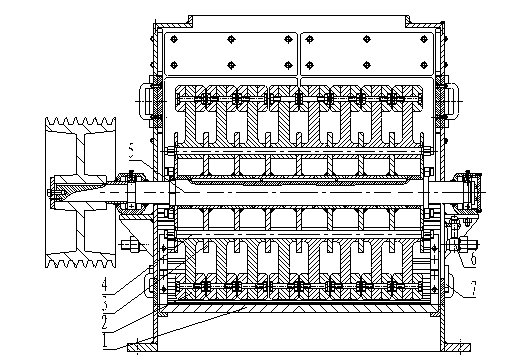
.
.
.
The overall structure of schematic hammer crusher
1- 2- sieve frame for hammer Crusher 3- 4- 5- pin and main axle and adjusting device 6- 7- sieve frame access door
It mainly consists of housing, rotor, grate, pads, hammer, linings and other components.
the main component of Hammer Crusher:
1- Housing :
the housing of the Crusher is Opened from above and it’s lined with High manganese steel liners to be replaced based on wear and tear and it must be changed periodically to avoid the material leakage so a seal also must be installed. there are more than one manhole to facilitate the Maintenance and to easily change liners and Hammers.
2- Rotor :
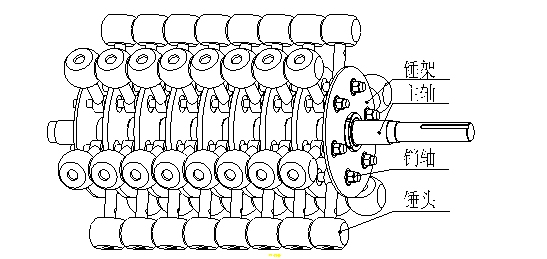
.
.
as shown in the above figure the rotor consist of shaft , Disk , Hammer Holder , Hammer Pins , and 6 Hanging Hammers on the Shaft . inorder to prevent the axial displacement and vibration both ends of the pin are locked with a locking Nut. the Rotor is supported by two self-aligning bearing. and inorder to store the kinetic energy there are two flywheels installed.
3- the Main Axle ( shaft )
the rotor shaft is the main part, it bear all the impact force . Therefore, the requirements of the material having a high strength and toughness, so 45 quenched and tempered steel its circular cross section, and has flat keys and other parts of the connection. As shown in below figure

.
4- Liners ( Hammer Crusher plates )
the Role of the Liners to absorb the Crusher Materials hits , to protect the crusher housing. after the collision with the liners if the material haven’t been crushed properly it will bound back to the Hammers to be crushed. Therefore the shape and structure of the Liners greatly influence the crushing process.
Two or three Breaker plates of Mn Steel casting are positioned to form an arc of the circle centered to the point of impact. The first plate is normally fixed in initial crushing zone. The second and the last plates are suspended from the frame through hinged connections. These are adjustable by heavy duty coil spring.
source : http://www.trf.co.in/pdf/Products/Impact%20Crusher.pdf
you can see example of the Liners here https://www.williamscrusher.com/hammer-mills/traveling-breaker-plate-mills
.
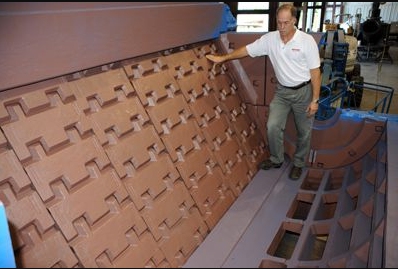
.
.
.
.
.
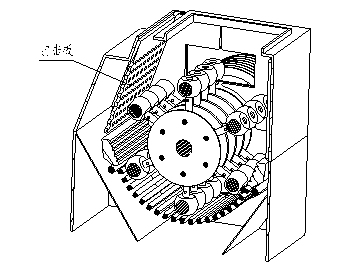
.
.
(5) hammers
Hammer is the main working parts. Its mass, shape, and material has a great influence on the production capacity of the crusher.
Thus, depending on the feed size to select the appropriate quality hammer. Hammer is wearing parts, often need to be replaced, in order to reduce the time required for replacement and labor intensity, I used modular hammer. 2.2 hammer can be used
Hammer with high-carbon steel casting or forging, can also be high manganese steel casting. In order to improve the wear resistance, and some hammer surface coated cemented carbide, and some high-chrome cast iron.
.
.
.
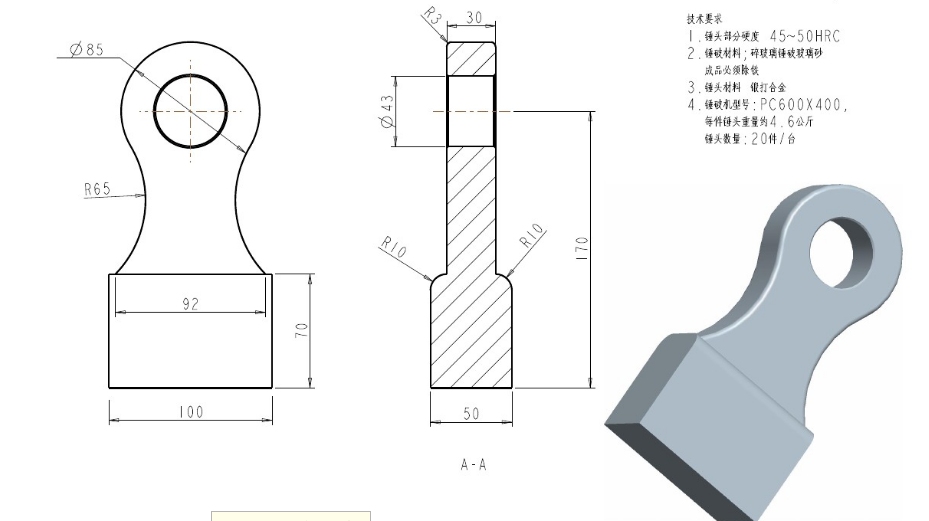
.
ll
.
.
.
.
.
.
.
.
.
.
.
.
.
.
.
.
.
(6) grate:
Grate arranged in the form of a direction of movement perpendicular to the hammer. And radius of gyration of the rotor have a certain gap arcuate qualified products through the discharge grate seam. Its cross-sectional shape of a trapezoid, a common cast manganese steel. Grate more as a set of steel bars of equal size, and the cross-sectional shape of the trapezoid.
.
.
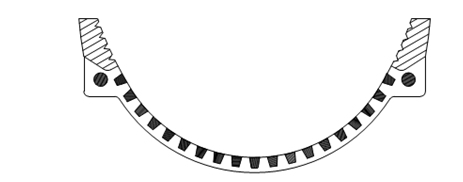
.
.
Rotor hammer crusher parameters calculation
Rotor diameter
The maximum diameter of the rotor can be calculated according to the Material block size with the below formula
D=(1.2 – 5 ) D(max)
D: Diameter of the Rotor
D(max ) : The maximum feed size
as an Example if you will crush Limestone and the Maximum block size = 300 mm , Calculate the Hammer crsuher rotor Diameter ?
For medium-sized hammer crusher , optional factor of 2.7, to take the middle value.
Therefore, D = 300 × 2.7 = 820mm
Rotor speed
Hammer crusher rotor speed according to the circumferential speed of the design, according to the formula
![]()
.
v– rotor circumferential speed, m / s;
D– rotor diameter, m
Rotor circumferential speed is generally between 18 ~ 70m / s . For small and medium crusher, taking v = 25 ~ 70m / s, and the speed at 750 ~ 1500r / min. Large crusher v = 18 ~ 25m / s, while the speed of 200 ~ 300r / min.
the higher the speed, the smaller the particle size, hammer, liner wear is faster, power consumption also increases, machining machine parts, installation accuracy requirements also will be increased to meet the particle size so the case The rotor circumferential speed should be selected low.
Take speed v 40m / s, then n = 931r / min.
Length of the rotor
Productivity and hammer crusher size, speed, discharge gap width, feed size, feed conditions and material properties and other factors. according to formula

.
.
Where Q– productivity, t / h;
D– rotor diameter, m;
P– density material, 1.6t /M3.
Taking K = 38;

.
.
Calculation of mass hammer
Because it hinged to the rotor, so that the right choice has a significant impact on the quality of the hammer crushing efficiency and energy consumption, if the hammer have low quality , it may not meet the material crushing requirements. If you choose too large, useless power consumption is too large, the centrifugal force is large, there will be an impact on other parts and make them easily damaged.
According to the Momentum theory to Calculate the Mass of the Hammer, when the Hammer Hit the Required Material to be crushed , there will be speed Loss. if this speed loss Exceeded Certain Level the Hammer will not Rotate around it’s axis and the hammer will stop revolving,